Spaces that work
From hybrid spaces to workplaces as an expression of company culture, Universal Design Studio discusses the future of the office
Let’s add audio for visually impaired audiences
How to make advertising more accessible for visually impaired audiences – by using audio descriptions – is top of mind for Matthew Stewart at WPP’s Satalia
While audio descriptions have been around for some time, they’re not always optimised for people who are visually impaired; and the descriptions are often not rich with detail and clear about intent. What is more, the slots for descriptions are often somewhat disruptive to the story.
“Let’s be clear about what we mean by audio descriptions. It’s the practice of having an operator speak over a video in a way that isn't disruptive to the story. The aim is that visually impaired audiences will get a sense – through audio – of what's going on in an advertisement or other viewable content,” says Stewart.
“We found that visually impaired audiences were being under-served. Brands weren't getting their message across, and the products weren't being best represented. So, we took a view on how we can improve all elements of the process – using large-scale machine-learning foundation models for content generation – to see how we can better solve the problem.”
Stewart says it all starts with perception. “Perception is about being able to understand more than we can see visually. It’s also about what the characters are doing, the story, the humour, how all that relates to your audience and how it also relates to the products and services you are trying to sell,” he says.
“Now we can use the best technology to tell the story through the language brands choose to use for that visually impaired audience that's being underserved.” But he also emphasises the importance of feedback loops to achieve long-term goals.
The time is now
“We've seen massive progress in the use of subtitles, so this seemed like a good time to bring audio description to the forefront of video production. We think audio description should not just be ‘nice to have’ but front and centre, and something that has the potential to be done at scale,” says Stewart. “We’ve reached a point where we can – using AI technology – flip a video into text and pictures so we can rearrange the story into any sequence we want.”
For advertising, this means, in effect, breaking down the content into chunks so that text can be injected between natural dialogue so as not to interrupt the flow of the story. But the clincher is that the audio descriptions – about the storyline, actors, what they're doing with the products and so on – is very strong given the underlying AI technology.
It’s no small thing that Satalia is part of the WPP network – which has formed partnerships with the likes of NVIDIA, Microsoft and Google – but also employs thousands of creatives occupying production studios across its global network, and it has the technical expertise to bring it all together.
But Stewart insists perception must be at the heart of audio description technology: “We're moving into a world that's content rich, so the task is about choosing the right content for the moment in question – that sounds to me like a perception issue. We must understand what drives people and what are their preferences. We need to know what kind of world they want to inhabit, and what kind of world, as a brand, are they are trying to represent. Then we have to work out how you articulate the content that describes that world.”
He also points out that – by generating information based off of the visual content and evaluating this against known best practice – biases or human error that might result from third-party translations are reduced.
“Using this tool in-house means the user knows how the creative work was built, for what audience, and the objective of the campaign,” says Stewart.
Why Satalia?
Satalia is expert in building decision-making systems. “And we've got deep expertise in not just data science – which is the modelling of information to predict what's going to happen and find patterns – but we also build systems that are able to make decisions on the fly aligned with a set of defined goals and objectives,” says Stewart.
“What's exciting about this tool is that we've taken the very best visual perception and analysis tool and given it a goal. It's able to work with those other tools we have built to generate that new audio content for visually impaired people.”
From the accessibility point of view, the tool not only performs for visually impaired audiences but also team members who are similarly visually impaired. But ultimately, perceptions – along with understanding audiences – is at the very heart of this tool.
Category
Explore More Topics
More in Experience
This is a test article page
This is a test article page to do a final check on the redesigned iQ Article Page 2024 story before it goes live.

Mechanisms that Matter – What it takes to lead an agency team for the world’s biggest brands
Top of the list: A ‘rabid curiosity’ about the new and an understanding of every role in the mix

